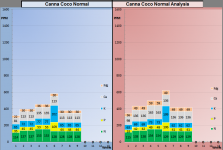G
greenmatter
Good post greenmatter, some good info there. Maybe someone with some chemistry education can chime in and give some info on calcium sources?
I'd like to read that book but have no bidget for buying books, sadly. If someone has it and can upload scans of the formulas, that would be fantastic.
I agree, Mel Frank seems to be the only one to have published nutrient profiles, I stick to his 200-100-200-60 NPKMg for veg/early bloom and 100-100-200-60 NPKMg for mid-late bloom and it works well for me, the Ionic nutes I've been using for a while (got em dirt cheap) happen to have those same ratios as Mel published which makes it pretty easy to stick to those ratios.
I know spurr has some info on nutrient profiles, maybe he will pop in and post it for us.
Disappointingly, that H&G PDF doesn't have any info on the ingredients, it mentions they use EDDHA as their Iron chelator but gives little other info.

sorry funky no scanner and i can't really type worth a damn ... got a couple friends i'm gonna try to get to help me out .. i will try





